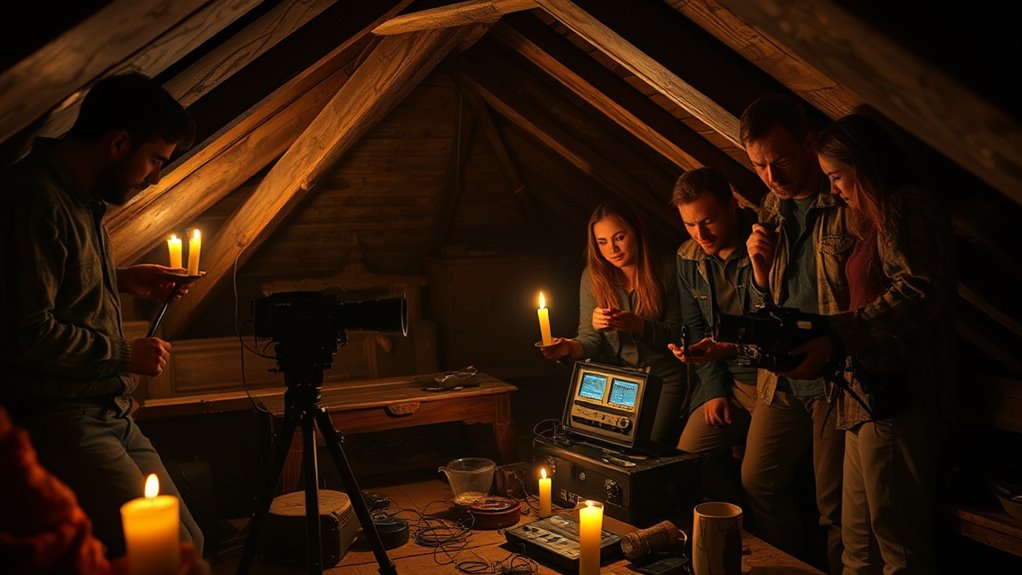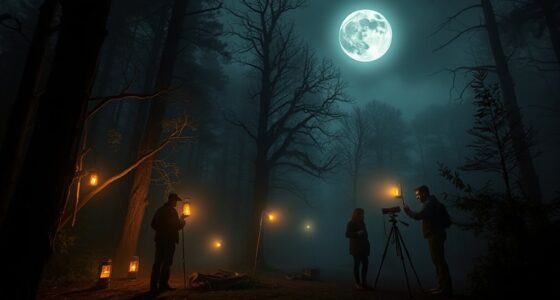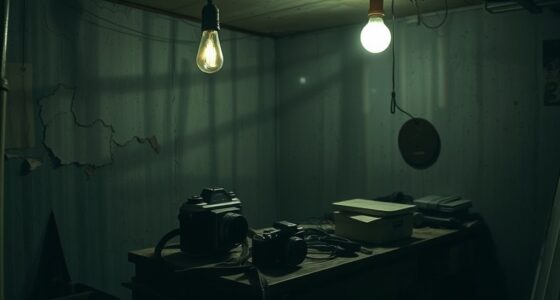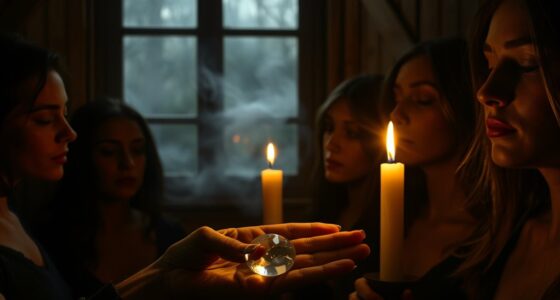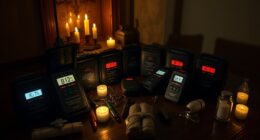On a ghost hunt, your team has specific roles to ensure a successful investigation. The lead investigator guides the team, makes quick decisions, and keeps everyone safe. Technical specialists set up and monitor equipment like EMF meters and cameras to spot paranormal signals. Researchers gather history and background info to focus your efforts, while support staff handle safety and logistics. Good teamwork and clear communication are key, and if you keep going, you’ll discover how each role contributes to uncovering the unknown.
Key Takeaways
- The Lead Investigator coordinates the team, plans the hunt, and interprets paranormal phenomena.
- Technical Specialists operate and troubleshoot equipment like EMF meters and cameras.
- Researchers gather historical data and focus investigation efforts based on legends and background info.
- Support personnel ensure safety, handle logistics, and assist team members during the hunt.
- Effective teamwork relies on clear communication, role understanding, and collaboration among all members.
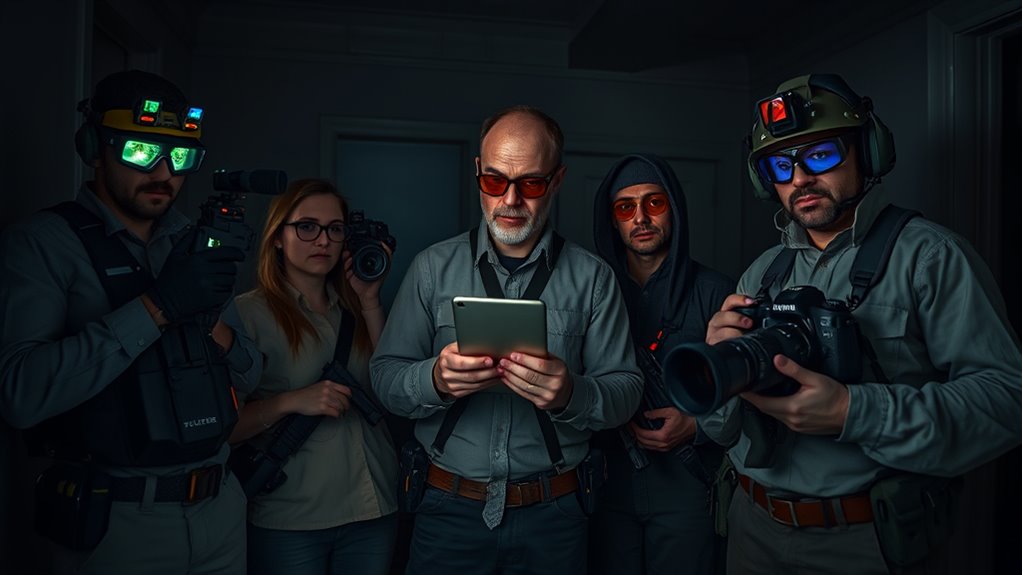
Have you ever wondered who’s behind the scenes making things happen during a ghost hunt? It’s not just about wandering around with equipment and hoping for a spooky encounter. Behind every successful paranormal investigation is a dedicated team working seamlessly together, each person playing a crucial role. Your understanding of team dynamics can make or break the experience, so knowing who does what helps you appreciate the effort involved.
First, there’s the lead investigator, the person who coordinates the entire operation. They set the plan, assign roles, and keep everyone focused. Their experience in paranormal investigations helps them interpret phenomena and make decisions on the spot. They’re also responsible for ensuring safety and maintaining a professional atmosphere, which is vital when dealing with potentially sensitive or intense situations. The lead’s role is central because they act as the team’s navigator through the unknown, making sure all members work cohesively.
Next, you have the technical specialists. These team members handle all the equipment—EMF meters, spirit boxes, cameras, and audio recorders. Their job is to set up, monitor, and troubleshoot devices during the investigation. Their expertise often lies in understanding how equipment works and recognizing genuine paranormal signals from false alarms. They keep detailed logs of their findings, which can be invaluable later for analysis. Because paranormal investigations rely heavily on technology, having someone who understands the tools is essential to maintaining solid team dynamics and ensuring accurate data collection. Additionally, understanding the role of technology in investigations is key to differentiating between real and false signals.
Then, there are the researchers or historians. They often do background checks on the location beforehand, gathering historical data and local legends. This knowledge helps the team focus their investigation and interpret any phenomena more accurately. Their insights can guide the team toward specific areas of interest or help explain certain occurrences, adding context to the paranormal activity. Their role emphasizes the importance of preparation and knowledge, which complements the more reactive aspects of the investigation. Additionally, understanding team roles and duties can enhance the overall effectiveness of the investigation.
Finally, you have the support and safety personnel. These team members assist with logistics, crowd control if needed, and ensure everyone stays safe during the hunt. They’re often the ones who handle emergencies or unexpected situations, keeping the team grounded. Their presence helps maintain a positive group dynamic, allowing more experienced members to focus on their roles without distraction.
All these roles work together as a well-oiled machine. Strong team dynamics foster trust, clear communication, and efficient cooperation—all essential during unpredictable moments in a paranormal investigation. Each role is interconnected, and understanding them helps you see that ghost hunts aren’t just about the spooky moments; they’re about teamwork, preparation, and precision. When everyone knows their duties, the investigation flows smoothly, increasing your chances of uncovering the truth behind the paranormal activity.
Frequently Asked Questions
What Qualifications Are Required to Join a Ghost Hunting Team?
To join a ghost hunting team, you need to meet specific training requirements and have some background experience. Most teams look for individuals who understand paranormal investigation tools and techniques. You don’t necessarily need formal qualifications, but gaining knowledge through workshops or courses helps. Your background in research, electronics, or psychology can be beneficial. Demonstrating a genuine interest and willingness to learn also increases your chances of becoming part of the team.
How Do Team Members Handle Disagreements During Hunts?
Handling disagreements during a hunt is like steering a stormy sea—you need calm and clear communication. You should rely on effective communication strategies and conflict resolution techniques to stay focused. Listen actively to each other, respect differing opinions, and find common ground quickly. If tensions rise, take a step back and discuss concerns calmly. This approach keeps the team united and ensures the hunt stays productive and respectful.
What Safety Measures Are in Place During Investigations?
During investigations, you follow strict paranormal safety and investigation protocols to guarantee everyone’s well-being. You wear appropriate gear, stay in groups, and keep communication open. You’re trained to recognize signs of distress or danger, and protocols include emergency procedures if needed. These measures help prevent accidents, maintain a safe environment, and allow you to focus on uncovering paranormal activity confidently and responsibly.
How Do Teams Choose Which Locations to Investigate?
Imagine a lighthouse guiding explorers through fog—your team uses that same beacon during location selection. You evaluate investigation criteria carefully, seeking sites rich in history and stories that stir curiosity. You consider safety, access, and potential evidence. By aligning these factors, you choose locations that promise meaningful experiences and genuine encounters, turning each investigation into a journey of discovery—where every place holds secrets waiting to be uncovered.
Can Team Members Have Personal Beliefs About the Paranormal?
You can absolutely have personal beliefs about the paranormal, and it’s common among team members. Some may be believers, while others hold paranormal skepticism. These differing views can actually benefit the investigation, as they bring diverse perspectives. Just remember, during a ghost hunt, professionalism and respect for others’ beliefs matter most. Your personal beliefs shouldn’t interfere with the team’s focus or the investigation’s integrity.
Conclusion
Now that you know the roles and duties on a ghost hunt, you’re ready to step into the team like a crucial piece of a puzzle. Just as each member contributes to solving a mystery, your role helps uncover the truth behind the spirits. Remember, teamwork is the key to a successful hunt—without it, you’re like a flashlight in the dark, flickering and unsure. Embrace your part, and let the adventure begin!
